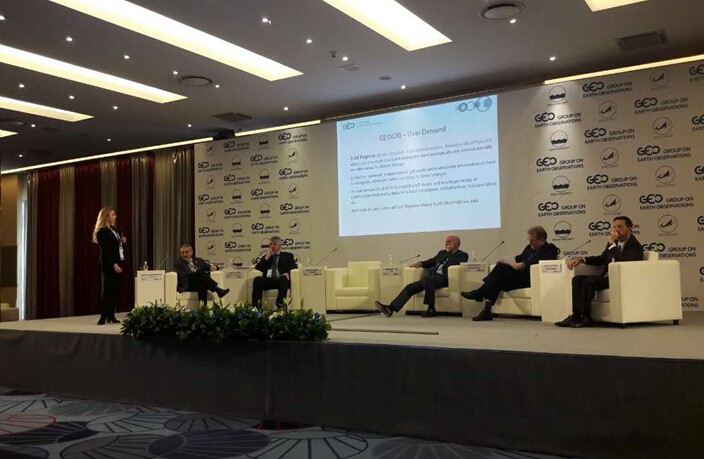The GEOCRI Symposium Held in St.Peterburg, Russia

The GEOCRI Symposium Held in St. Petersburg, Russia
On November 8, 2016, the Symposium on the GEO Cold Regions Initiative (GEOCRI) was held in St. Petersburg, Russia. The symposium was based on a theme titled “To Strengthen the Development and Implementation of the GEOCRI”. More than 40 experts from Russia, Finland, Norway, Canada, Switzerland, Germany, the United Kingdom, China, Japan, and Chile were present at the meeting.
GEOCRI, one of the GEO Initiatives, was supported by nearly 20 countries and regions as well as international plans and organizations. QIU Yubao, Associate Research Fellow of RADI and a main coordinator of the initiative, holds a position in GEO. Qiu introduced the concepts, demands, and the implementation plans of GEOCRI and, on behalf of Academician GUO Huadong, discussed the scientific thoughts and practices for “the comparative study on the three poles of Earth” in terms of the scientific problems in Earth's cold regions.Dr. Qiu stressed that, in the context of rapid global environmental change, Earth’s three poles are sensitive areas that change and respond to the global environment and are therefore key areas for research. The three poles are correlated with each other, with the greatest difference being their location.
The meeting was also attended by representatives from the World Meteorological Organization (WMO), Sustaining Arctic Observing Networks (SAON), the European Centre for Medium-Range Weather Forecasts (ECMWF), the International Society for Digital Earth (ISDE), and the International Network for Terrestrial Research and Monitoring in the Arctic (INTERACT).The meeting was hosted by GEOCRI. QIU Yubao and Ph.D. Hannele Savela of University of Oulu, Finland, co-chaired the symposium. Fourteen speeches were given on the scientific understanding of global cold regions and related observations as well as the implementation and development of GEOCRI.
 GEOCRI was invited to attend the expert forum of the GEO-XIII Plenary.
GEOCRI was invited to attend the expert forum of the GEO-XIII Plenary.
Dr. Qiu suggested that we should take a holistic approach when studying the three poles of Earth in order to systematically understand the synchronous and asynchronous mechanism for global change and development. This approach is useful for unveiling scientific phenomena that is difficult to obtain when only studying a single pole. Space-to-Earth observation is an important foundation and method for the comparative study of the three poles, and is the only means for realizing large-area, multi-scale, long-cycle, spatially seamless, and temporally continuous data acquisition.
Prof. Terry V. Callaghan, an outstanding scientist representing Russian Tomsk State University and the Royal Swedish Academy of Sciences, delivered an academic speech titled “Scientific Concepts of Large Section and Super Large Section”. He stated that exchanges and changes of energy, materials, and species on Earth require knowledge-oriented management that is based on an environmental footprint within key spheres of cold regions in order to fully understand the organic collaboration of Earth observation, model simulation, and remote sensing, and to improve scientific understanding. Based on the INTERACT built by the EU’s Seventh Research Framework Programme (FP7), he elaborated on Russia’s cooperation with international scientists and the proposed development of the Network for Siberia’s Large Section, which is designed in order to foster an intercontinental cooperative method for the Earth system, with plans to build possible physical models.
WMO introduced the work and activities of Global Cryosphere Watch (GCW), Polar Space Task Group (PSTG), and the Committee for Observation and Services in Polar and Mountainous Regions for observation of cold regions. SAON discussed the construction and development of SAON. The European Space Agency (ESA) showcased the development of satellites, and its capabilities of Earth observation of changes in the polar ice caps as well as ice and snow in space. Three reports were completed by Russian scientists from hydrological and meteorological institutes and universities, focusing on the observation and research of greenhouse gases in polar areas and Eurasia, ice and snow, and the ecological system in the Far North. The Pan-Eurasian Experiment (PEEX) detailed the Pan-Eurasian Ground Observation Network and stressed the urgency and necessity of coordination between ground observation and remote sensing.
 Prof. Terry V. Callaghan, a scientist from Russian Tomsk State University and the Royal Swedish Academy of Sciences, delivers a speech.
Prof. Terry V. Callaghan, a scientist from Russian Tomsk State University and the Royal Swedish Academy of Sciences, delivers a speech.
The Integrated Arctic Observing System (INTAROS) project and the INTERACT II are two large-scale integrated research projects in the Arctic and the Holarctic of the EU Horizon 2020, which are scheduled to be initiated in January 2017. At the meeting, the Norway Nansen Environmental and Remote Sensing Center (NERSC) and the University of Oulu in Finland respectively detailed the implementation of their main projects, as well as projects supporting GEOCRI.
Through discussions, experts from Russia and other countries will cooperate with each other to conduct relevant programs by forming a GEOCRI task group in order to support the development of scientific programs in cold regions. The Global Mountain Observation Network hosted by the Mountain Research Initiative (MRI) and GEOCRI will jointly promote substantial cooperation.
On November 9, GEOCRI was invited to hold an expert forum during the GEO plenary, receiving positive responses from members of GEO and relevant organizations.